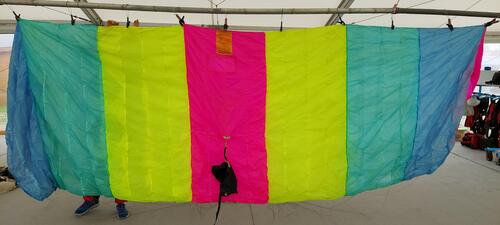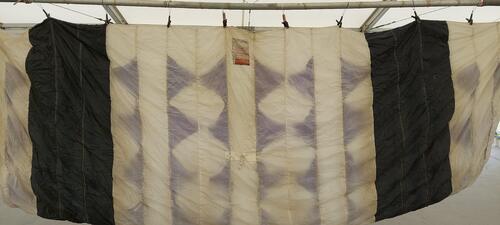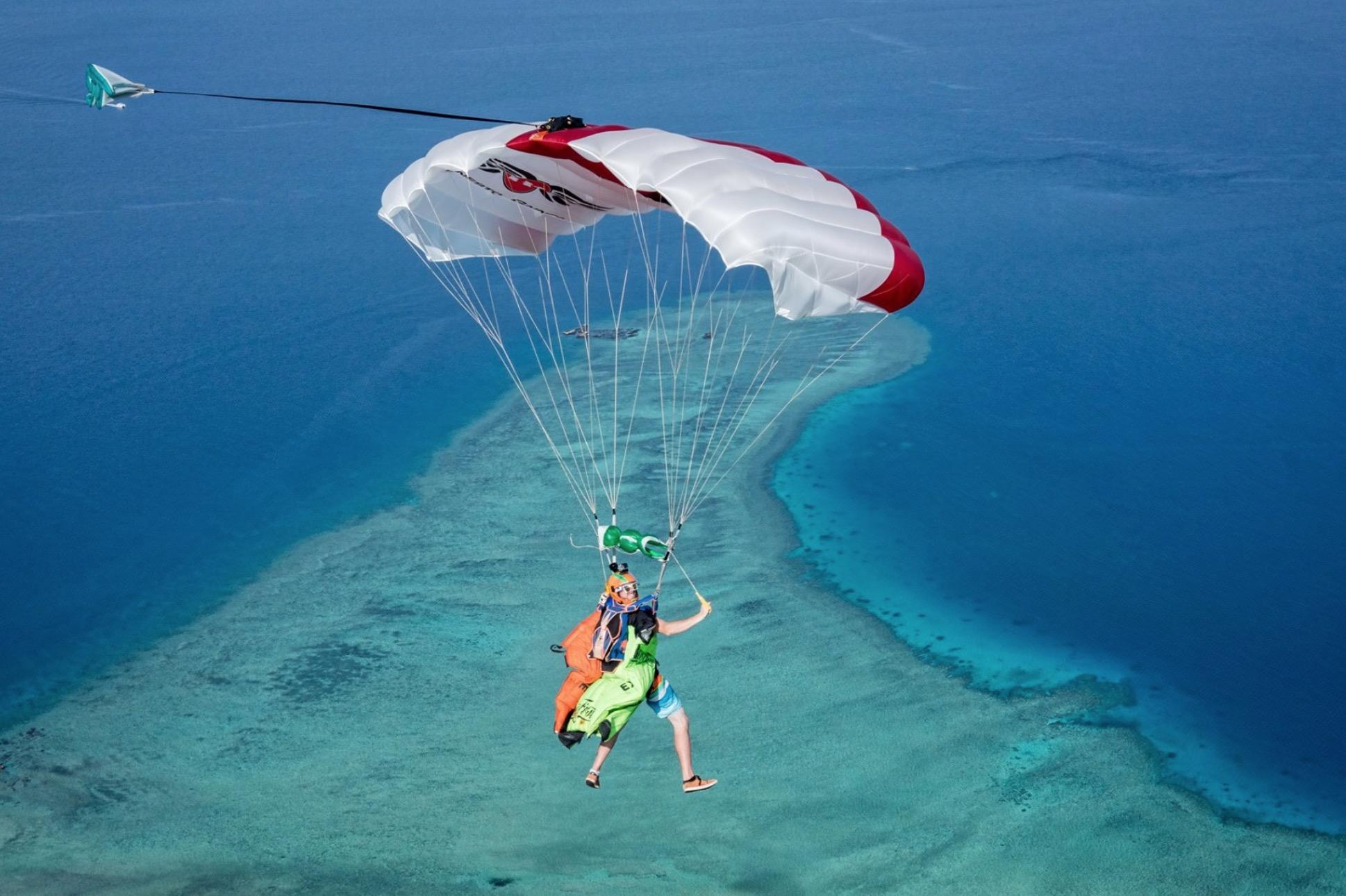Search the Community
Showing results for tags 'canopy'.
Found 12 results
-
This is my first time buying a rig. Found a used Mirage G4.1 M3 container in pretty good state, and was looking to use it with a Sabre 2 150ft main, DOM 2016 with around 650 jumps in the canopy (new lines though). In Mirage's website sizing chart, they mention a Sabre 2 150 as a 'firm' fit and I'm a little confused with what exactly that means in practical terms. Should I not use such combination as it could be too tight? I saw quite a few people say they managed to fit a Sabre 170 in a MIrage G4 M3, including the current owner of such container, so I should be fine?? Maybe Mirage is a little conservative in their sizing chart (?) The plan is to also get a 150ft reserve, not sure of which one yet, so kinda worried about that as well. Anyone has experience with such combination or similar? Any help would be appreciated as I'm a newbie in container info Blue skies!
-
Time Left: 13 days and 5 hours
- FOR SALE
- USED
‘Ninja 2' 94 main: DOM 2005. 500 Jumps. Original lines. One patch (visible in the photos). Photos attached, disable AdBlock and refresh the page if you cannot see them. I air ship world-wide. Takes approx 20 calendar days worldwide. I am reputable Dropzone.com user with over 3000 posts in the last 15 years. Master Rigger sale references available, your choice of payment method! Email me at: SKYDIVER.FLY123456@GMAIL.COM See the *NARROWED-DOWN* Dropzone.com LIST of *ONLY MY PARACHUTES* for SALE ! : Click the LINK BELOW, where it says the words: ' CLICK HERE ' --> CLICK HERE for a LIST of my RESERVES <--$799.00
-
Time Left: 13 days and 5 hours
- FOR SALE
- USED
‘PD Velocity 90' main: DOM 2004. 1500 Jumps. Needs reline. Photos attached, disable AdBlock and refresh the page if you cannot see them. I air ship world-wide. Takes approx 20 calendar days worldwide. I am reputable Dropzone.com user with over 3000 posts in the last 15 years. Master Rigger sale references available, your choice of payment method! Email me at: SKYDIVER.FLY123456@GMAIL.COM See the *NARROWED-DOWN* Dropzone.com LIST of *ONLY MY PARACHUTES* for SALE ! : Click the LINK BELOW, where it says the words: ' CLICK HERE ' --> CLICK HERE for a LIST of my RESERVES <--$599.00
-
I wanted to know which canopy shape is the best for slowest descent. I'm making a miniature parachute for a physics assignment and wanted to investigate the effect on the descent rate when the diameter of the spill hole is changed. Also can all canopies have spill holes or only some of them. Thanks in advance.
-
Guys I am having 117 jumps and now looking to buy my own rig. I am looking for 170 main canopy. My height is 5 Feet 6 inches in CM it is 167.64. Weight 81 kg
-
Performance Designs is beyond thrilled to announce the release of the long-awaited Sabre3. For nearly 40 years, their design team has worked tirelessly to refine what is possible in canopy design, and they've done it again, delivering yet another cutting-edge canopy to the skydiving community. The Sabre3 is not only worthy of the name, it redefines it. This new wing exemplifies PD's continued passion to build the next greatest all around 9-cell modern canopy, one which is sure to excite anyone who flies it, and truly amaze those new to the brand. One flight proves it: it's not just a new wing, it's a better wing. Though the Sabre3 shares a lineage with two historically popular Performance Designs canopies, the Sabre and Sabre2, the designers began with a clean slate with the goal of creating the world’s next most popular canopy. They enhanced the qualities people loved most about the Sabre2 but minimized or eliminated those some found less desirable. Already tested endlessly by PD Test Jumpers, and demoed by PD Athletes, the Sabre3 has been described as dynamic, powerful, and perfectly suited for today’s modern canopy pilot - delivering superb openings, crisp response, and amazing landings. “The Sabre3 definitely has the range to be a great straight in, no wind, standard landing type canopy for a lower experience jumper. Or you can really push it and get some amazing flight performance out of it. It’s pretty much for the world. What we want as skydivers is a reliable canopy that is predictable on opening all the way through landing. It really is a beautiful wing. ”- Brad Cole, PD Test Jumper The Sabre 3 is not just a new wing, it’s a better wing. You asked, they listened and delivered once again. Like all of their canopies, Performance Designs’ Sabre3 is available for demo before purchase. Those ready to own one should contact their local Authorized PD Dealer to discuss if the canopy is right for them. Additional specs and stats can be found on the Performance Designs website.
-
I don't know if this is a topic that has ever been discussed, but i wanted to bring it up because I haven't came across any post. I've read plenty of articles debating a variety canopy flight and deployment characteristics, but nothing about altitude loss. I'm particularly interested in talking about the snivel/altitude loss of canopies. I understand it's nothing serious to consider when skydiving because the deployment altitude is higher than base jumping per say. However, it's something i'm personally interested in learning about and wanted to see if anyone else had any input? I've read articles about the Pilot or Safire 3 having severe snivel characteristics, so how does that relate to altitude loss? - Is a snivel characteristic correlated to altitude loss? - Is a hard opening caused by the canopy opening quicker, thus losing less altitude? Interested to see if anyone has any input?
-
Hi guys, has someone already tried the new Kraken by NZ? What do you think of it? I bought one (129 size) but only managed to do 1 jump before the winter arrived. Therefore I cannot say much except the opening was stable and on heading. The flare is a bit weak but it might be down to being cautious and not loading it too much. thank you
-
“She’s a wing of legends. The Kraken is the ultimate 'party in the front and business at the back', she's super responsive and holds tight when pushed hard. She is the canopy equivalent of Che Guevara, Marilyn Monroe and Brian Jones all in one. The Kraken is a must have for any wingsuiter and will have the pilot grinning ear to ear as they fly back to whatever landing area they can make it to. Kidding. Kinda.” We have released the Kraken, finally! Designing the Kraken was a long process because it was new to us: the Kraken is our very first wingsuit specific parachute. Traditionally NZ Aerosports has focused more on flight performance than on opening a canopy in a wingsuit wake. So it took us a few years, but ended up with a very technical end result: a canopy full of cool features and ideas that makes it very different from any existing wingsuit canopy. The result is a low bulk, long lasting canopy with very reliable and stable openings that lands like a dream. Typically, canopies low(er) in aspect ratio and ellipticity (fat 7-cell canopies) have better heading performance, and stability in flight. The problem with this is that wings shaped like this are not exactly renowned for their glide performance and sharp handling. The solution to this problem was a combination of ideas floating around the head of NZ Aerosports’ aeronautical engineer Julien Peelman, and the production and test jump team. We looked to our deep understanding of modern day wings, aerodynamics, and type of ingenuity that produces world class skydiving parachutes – our trademark. Key features of the Kraken 3D Designed: We are now using Catia V5 to design canopies. This is one of the most advanced 3D CAD softwares available. It gives us more freedom to design the canopy down to the finest details and helps generate the most accurate panels possible. The result is a more accurate shaping, a smoother surface, and better aerodynamic efficiency. CFD Tested: The Kraken shape has been tested using CFD (Computational Fluid Dynamics), which gives us, among other things, a better understanding of her behavior in turbulence and during recovery. Photo Chris Stewart Anticipating the zag: First debuted in our Crossfire 3, The Kraken is designed so its panels are designed directly in the shape they will have during flight by taking into account the Zig-Zag distortion. This spreads the load evenly through the fabric and makes the wing more structurally efficient. New Rib Shape: The Kraken has benefited from research on rib shaping that was originally used to design our new range of hyper-performance wings, Petra and Leia. New Crossport Design: Crossports have been strategically placed in the Kraken to have the least influence on the upper surface shape while allowing a good air circulation between the chambers. They are bigger toward the center of the canopy to help with symmetrical openings. They have also been designed with an elliptical shape that optimizes their area while reducing the upper surface distortion. Powerband: We've added the split leading edge Powerband to all our new canopies since we pioneered it with Petra. It allows us to better control the aerodynamic shape in the nose area, which prevents parasitic drag. Curves in the right places: We’ve realised that by sewing our reinforcing tape in parabolas (arcs) on the ribs, we spread the load applied to the top surface more efficiently, meaning less distortion and a more efficient top surface. Don’t say slit: We’ve put a vent on the lower surface to help promote fast center cell inflation. This means better, more on heading openings in the messy wake of a wingsuit. It’s not a gaping hole like a BASE vent, it’s a… horizontal opening... that seals after full inflation. There’s a hole in my slider?!: We became so fond of vents that we put one in the slider! We found that by creating a channel for the air to go straight through, we reduced the crazy oscillation often seen during parachute openings. Those oscillations can contribute to off headings etc, so that’s nice! Big holes: To help out its closest neighbors, the crossports leading from the center cell to the closest outboard cells are enlarged. Promoting symmetrical central inflation means promoting on heading openings! Keeping it short: Shorter lines mean more flight stability, and easier rectification of any pesky line twists – both good things for the whole wingsuit deal! High-tech, low bulk: Because it’s 2019, we haven’t used untreated cloth (F-111) for our wingsuit canopy. Instead, we’ve tracked down a low bulk ZP (treated with silicone) fabric, and used that for the majority of the wing, with the Powerband and top center panel made out of standard ZP for extra longevity. Riser equality: We’ve included a bit of internal structure that means your bridle will load both your risers more evenly during the early stages of deployment. Because of how it looks, we’ve called it the ‘Bow-tie’ – and as we all know, equality is classy! Photo Chris Stewart Little tail thingys: Mini-ribs in the tail of a canopy sharpens its profile, which reduces drag and increases glide performance by “a lot more than we thought”. This translates to more fun in the sky, and a better flare on the ground. 7 cells are not usually known for their amazing flare power, so it all helps! Improve your pull-out game with a snatch: Symmetry is good, and so it is with your pilot chute. We’ve discovered that using snatches help with our wingsuit openings, so we have stocked up on them and highly recommend to purchase one with all Kraken purchases! Inward Rotated end cell: While most ribs are perpendicular to the lower surface, the end rib is rotated inward to reduce the size of the end cell and prevent it from losing its shape. This reduces tip vortices and induced drag. Photo Chris Stewart New line trim: Despite being a relatively docile canopy, the rectangular planform has been compensated with a trim just a notch steeper than you would think. This helps with up wind penetration, fun and is one of the reason for the great flare. New Stabilizer shape: The shape of the stabilizer has been modernized to prevent it from flapping too much in flight. It also helps the slider to sit in the right position. Custom Sizing The Kraken is available in any size between 119 and 189 so that you can get the perfect wing loading for you at this stage in your canopy progression. See the Kraken’s key features interactively on Emersya: https://emersya.com/showcase/5GFIH0C9Q0 Key flight characteristics of the Kraken Openings The modern day wingsuit is capable of incredible glide, but this efficiency brings its own set of complications when designing a parachute to match. The biggest factor is the turbulent wake formed behind the wingsuit – right where the parachute is deployed. Kraken openings are quick but not hard – you’ll feel inflation immediately. The vent helps control the heading. Once the center cell and adjacent cells inflate, the canopy slowly pressurises with a predictable reliability. The Kraken will sail on level seas even with linetwists! Inputs Intuitive and precise, each input delivers a predictable response. From opening to landing the Kraken is a confidence builder. Toggles Big inputs will produce an immediate response - the pilot will feel in control from first point of contact. Stall point The slow flight characteristics were a very important design factor for the Kraken, so there is plenty of warning before she stalls, and will recover to normal flight in an easy and stress free transition when slowly letting the toggles back up. Rear risers There’s lots of feel and response – the Kraken has fantastic glide! Milk those rears and disprove the myth that all wingsuiters land off! Front Risers F is for fun! Yep, the Kraken can dive! Performance The Kraken has loads of zip! Fly her nice and slow for those busy landing patterns when you want lots of vertical separation. Or dive her at the ground and drag some turf. There’s plenty of fun to be had! Recovery Arc The recovery arc is longer than typically experienced with similar 7 cell designs. For someone who wants to have their cake ( a nice sensible wingsuit canopy) and eat it too (swoop the shit out of it), then go go go! Flare The Kraken has a wide range of performance, the flare is one of the most important aspects - she wont disappoint. Those nil wind tiptoe landings will feel very natural. More information available from:
-
Tried looking for this post before I posted it couldn’t find any so if there’s already some with the same exact question I apologize, wanted to know if it’s a dumb idea to buy a main with unknown jump numbers? Will have a rigger inspect it but it’s in another country shipping is kinda pricey along with the pay pal fees will add up. Appreciate any feedback you guys might have, also if anyone had good or bad luck with the same situation. Thanks
-
Hey guys, I've seen some posts about youngest skydiver to complete 1000 jumps but how about the youngest swooper? I am 17 and haven't competed yet but I plan on doing so and jump a JVX 69 loaded as 2.6 and swoop 810's for 110-120m on gates. What have you guys seen?
-
Hi, I have gotten mixed answers to this question so I wanted to ask here. Hopefully someone who owns one of these can chime in or a rigger who has experience with them I was told that the TSO may be written in a way that some riggers will pack it and others will not. Another source told me it has a TSO and there is no problem. The one I'm looking at was manufactured on 1999 if that makes a difference Anybody have any experience with this?






